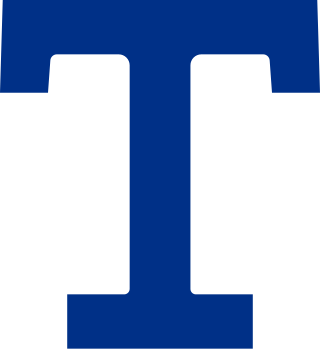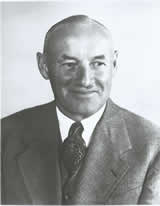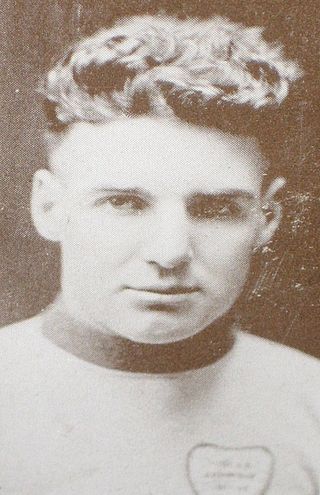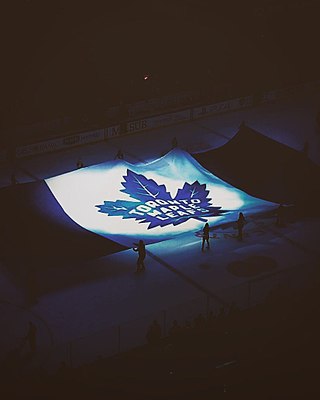
The Toronto Maple Leafs are a professional ice hockey team based in Toronto. The Maple Leafs compete in the National Hockey League (NHL) as a member of the Atlantic Division in the Eastern Conference. The club is owned by Maple Leaf Sports & Entertainment, a company that owns several professional sports teams in the city. The Maple Leafs' broadcasting rights are split between BCE Inc. and Rogers Communications. For the first 14 seasons, the team played its home games at the Mutual Street Arena, before moving to Maple Leaf Gardens in 1931. The Maple Leafs moved to their present home, Scotiabank Arena, in February 1999.

The Toronto Arenas or Torontos were a professional men's ice hockey team that played in the first two seasons of the National Hockey League (NHL). It was operated by the owner of the Arena Gardens, the Toronto Arena Company. As the ownership of the National Hockey Association (NHA) Toronto Blueshirts franchise was in dispute, the new NHL league was started, and a temporary Toronto franchise was operated. The NHL itself was intended to only be a one-year entity until the NHA could be reactivated, although it never was.

The Conn Smythe Trophy is awarded annually to the most valuable player (MVP) of his team during the National Hockey League's (NHL) Stanley Cup playoffs. It is named after Conn Smythe, the longtime owner, general manager, and head coach of the Toronto Maple Leafs. The Conn Smythe Trophy has been awarded 54 times to 47 players since the 1964–65 NHL season. Each year, at the conclusion of the final game of the Stanley Cup Finals, members of the Professional Hockey Writers' Association vote to elect the player deserving of the trophy. The trophy is handed out by the NHL Commissioner before the presentation of the Stanley Cup and only the winner is announced, in contrast to most of the other NHL awards which name three finalists and are presented at a ceremony. Vote tallies for the Conn Smythe Trophy were released starting in 2017.
The 1918–19 NHL season was the second season of the National Hockey League (NHL). While at first it was uncertain that the NHL would operate, and the possibility that National Hockey Association (NHA) would be resumed, the unfinished business of Eddie Livingstone's Toronto and Ottawa's NHA franchise, led to the NHL owners suspending the NHA again. Livingstone would attempt to overthrow the NHA management, and failing that, attempt to operate a rival league. The pre-season was filled with legal actions, deceptions and public verbal attacks. Ultimately, the NHL operated with three teams, in Montreal, Ottawa and Toronto. However, the season ended early with Toronto suspending operations, leaving Montreal and Ottawa to play off for the championship. Montreal would win the playoff and travel to Seattle for the Stanley Cup Finals. However, the championship series was not completed due to influenza infecting the whole Montreal team and causing the eventual death of Montreal's Joe Hall.

Constantine Falkland Cary Smythe MC was a Canadian businessman, soldier and sportsman in ice hockey and horse racing. He is best known as the principal owner of the Toronto Maple Leafs of the National Hockey League (NHL) from 1927 to 1961 and as the builder of Maple Leaf Gardens. As owner of the Leafs during numerous championship years, his name appears on the Stanley Cup eight times: 1932, 1942, 1945, 1947, 1948, 1949, 1951 and 1962.

The Toronto Hockey Club, known as the Torontos and the Toronto Blueshirts, was a professional ice hockey team based in Toronto. They were a member of the National Hockey Association (NHA). The club was founded in 1911 and began operations in 1912. The club won its sole Stanley Cup championship in 1914.

Edward James Livingstone was a Canadian sports team owner and manager. He was the principal owner of the Toronto Shamrocks and the Toronto Blueshirts professional ice hockey clubs of the National Hockey Association (NHA), where his battles with his fellow owners led them to create the National Hockey League.
The 1926–27 NHL season was the tenth season of the National Hockey League. The success of the Boston Bruins and the Pittsburgh Pirates led the NHL to expand further within the United States. The league added three new teams: the Chicago Black Hawks, Detroit Cougars, and New York Rangers, to make a total of ten, split in two divisions. This resulted in teams based in Canada being in the minority for the first time. To stock the teams with players the new teams brought in players from the Western Hockey League, which folded in May 1926. This left the NHL in sole possession of hockey's top players, as well as sole control of hockey's top trophy, the Stanley Cup, which was won by the Ottawa Senators. This was the original Senators' eleventh and final Stanley Cup win. The Senators' first was in 1903.

Clarence Henry "Happy" Day, later known as Hap Day, was a Canadian professional hockey player who played 14 seasons in the National Hockey League for the Toronto Maple Leafs and New York Americans. Day enjoyed a 33-year career as a player, referee, coach and assistant general manager, 28 of which were spent in various capacities with the Maple Leafs. He was inducted into the Hockey Hall of Fame in 1961.

Harold Hugh Cameron was a Canadian ice hockey defenceman who played professionally for the Toronto Blueshirts, Toronto Arenas, Ottawa Senators, Toronto St. Pats, and Montreal Canadiens. Cameron won three Stanley Cups in his career: his first as a member of the 1913–14 Toronto Blueshirts, his second as a member of the 1917–18 Blueshirts (Arenas), and his third as a member of the 1921–22 Toronto St. Pats.

Cecil Henry "Babe" Dye was a Canadian professional ice hockey forward who played 11 seasons in the National Hockey League (NHL) for the Toronto St. Patricks/Maple Leafs, Hamilton Tigers, Chicago Black Hawks, and the New York Americans between 1919 and 1930. Born in Hamilton, Ontario, Dye was known as an excellent stick-handler, and goal-scorer.
The 1952–53 NHL season was the 36th season of the National Hockey League. The Montreal Canadiens were the Stanley Cup winners as they beat the Boston Bruins four games to one in the final series.
The 1922 Stanley Cup Finals was contested by the National Hockey League (NHL) champion Toronto St. Patricks and the Pacific Coast Hockey Association (PCHA) champion Vancouver Millionaires. The St. Pats defeated Vancouver three games to two in the best-of-five game series to win their only Stanley Cup as the St. Pats.

The history of the Toronto Maple Leafs, a professional ice hockey team in the National Hockey League (NHL), begins with the establishment of the NHL itself. Both the Toronto Maple Leafs and the NHL arose from disputes between Eddie Livingstone, owner of the National Hockey Association's Toronto Blueshirts, and the other team owners of the Association. In November 1917, these other team owners founded the NHL, and granted Toronto a temporary franchise in their new league. Playing at Arena Gardens, this temporary team, the Toronto Arenas, won the 1918 Stanley Cup Finals following the inaugural 1917–18 NHL season. The NHL made the franchise permanent in October 1918.

Charles Laurens Querrie was the first General Manager of the Toronto Maple Leafs, at the time called the Toronto Arenas (1917–20) and the Toronto St. Patricks (1920–27).

The 1917–18 Toronto Hockey Club season was the first season of the new Toronto franchise in the newly-organized National Hockey League (NHL). The team was intended as a 'temporary' franchise, operating without an official club nickname and without a formal organization separate from the Toronto Arena Company that managed the Arena Gardens. Despite this, the team came together to win the first NHL Championship, competing against existing teams that had transferred directly from the National Hockey Association (NHA). Toronto would go on to win the Stanley Cup by defeating the Pacific Coast Hockey Association champion Vancouver Millionaires – the first Stanley Cup for an NHL team and the second Cup for a Toronto team after the Toronto Blueshirts' victory in the 1913–14 season of the NHA. To this day, the Toronto Arenas are the only team in the four major North American sports to win the title in their first season as a franchise.

The National Hockey League (NHL) was founded in 1917 following the demise of its predecessor league, the National Hockey Association (NHA). In an effort to remove Eddie Livingstone as owner of the Toronto Blueshirts, a majority of the NHA franchises suspended the NHA and formed the new NHL. The Quebec Bulldogs, while a member, did not operate in the NHL for the first two years. Instead the owners of the Toronto Arena Gardens operated a new Toronto franchise. While the NHL was intended as a temporary measure, the continuing dispute with Livingstone led to the four NHA owners meeting and making the suspension of the NHA permanent one year later.
The 1918–19 Toronto Arenas season was the second season of the Toronto franchise of the National Hockey League. After being operated on a temporary basis in the previous year, the team became a formal entity, known as the 'Toronto Arena Hockey Club.' The club played 18 games and suspended operations.
The 1926–27 Toronto St. Patricks season was the tenth season and the last under the St. Patricks banner for the Toronto National Hockey League (NHL) franchise. In February 1927, Conn Smythe and investors purchased the St. Patricks and changed the name to the Toronto Maple Leafs. On the ice, the team finished in fifth place, out of the playoffs.

The Canadiens–Maple Leafs rivalry is an ice hockey rivalry between the Montreal Canadiens and Toronto Maple Leafs, two professional ice hockey clubs in the National Hockey League (NHL). The Canadiens and Maple Leafs are the league's oldest teams, with the former established in 1909 and the latter in 1917. Both clubs compete in the Atlantic Division of the NHL's Eastern Conference.













